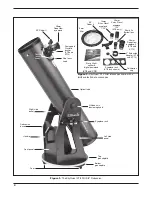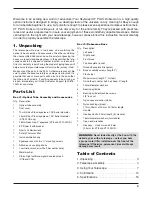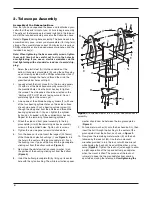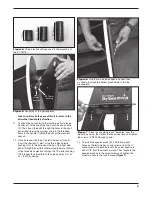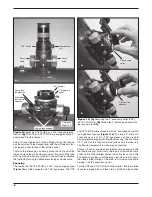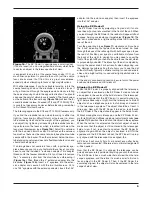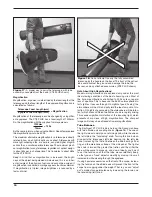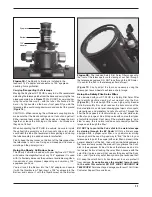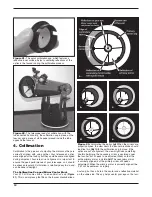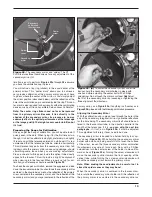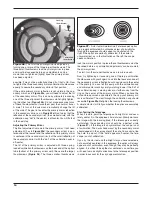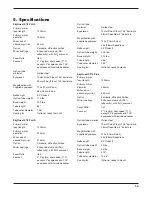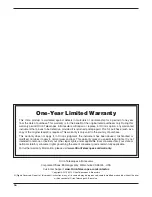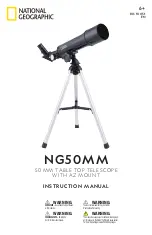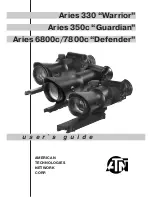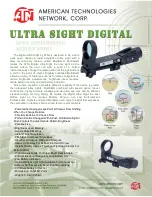
14
possible. It may not be perfectly centered, but that is OK. Now
re-tighten the three secondary mirror collimation thumbscrews
equally to secure the secondary mirror in that position.
If the entire primary mirror reflection is not visible in the sec-
ondary mirror, as in
Figure 23c, you will need to adjust the tilt
of the secondary mirror. This is done by alternately loosening
one of the three alignment thumbscrews while lightly tighten-
ing the other two (
Figure 25b). Do not make excessive turns
of these thumbscrews or force them past their normal travel.
A mere 1/4 turn of the screw can dramatically change the tilt
of the mirror. The goal is to center the primary mirror reflection
in the secondary mirror, as in
Figure 23d. Don’t worry that the
reflection of the secondary mirror (the smallest circle, with the
collimation cap “dot” in the center) is off-center. You will fix that
in the next step.
Adjusting the Primary Mirror
The final adjustment is made to the primary mirror. It will need
adjustment if, as in
Figure 23d, the secondary mirror is cen-
tered under the focuser and the reflection of the primary mirror
is centered in the secondary mirror, but the small reflection of
the secondary mirror (with the “dot” of the collimation cap) is
off-center.
The tilt of the primary mirror is adjusted with three spring-
loaded collimation thumbscrews on the back end of the optical
tube (bottom of the primary mirror cell); these are the larger
thumbscrews
(Figure 26). The three smaller thumbscrews
lock the mirror’s position in place; these thumbscrews must be
loosened before any collimation adjustments can be made to
the primary mirror.
To start, turn the smaller thumbscrews a few turns each.
Now, try tightening or loosening one of the large collimation
thumbscrews with your fingers. Look into the focuser and see if
the secondary mirror reflection has moved closer to the center
of the primary. You can tell this easily with the collimation cap
and mirror center mark by simply watching to see if the “dot” of
the collimation cap is moving closer or farther away from the
ring on the center of the primary mirror. When you have the
dot centered as much as possible in the ring, your primary mir-
ror is collimated. The view through the collimation cap should
resemble
Figure 23e. Retighten the locking thumbscrews.
A simple star test will tell you whether the optics are accurately
collimated.
Star-Testing the Telescope
When it is dark, point the telescope at a bright star and accu-
rately center it in the eyepiece’s field of view. Slowly de-focus
the image with the focusing knob. If the telescope is correctly
collimated, the expanding disk should be a perfect circle
(
Figure 27). If the image is unsymmetrical, the scope is out
of collimation. The dark shadow cast by the secondary mirror
should appear in the very center of the out-of-focus circle, like
the hole in a donut. If the “hole” appears off-center, the tele-
scope is out of collimation.
If you try the star test and the bright star you have selected is
not accurately centered in the eyepiece, the optics will always
appear out of collimation, even though they may be perfectly
aligned. It is critical to keep the star centered, so over time you
will need to make slight corrections to the telescope’s position
in order to account for the sky’s apparent motion.
Figure 27.
A star test will determine if a telescope’s optics
are properly collimated. An unfocused view of a bright star
through the eyepiece should appear as illustrated on the
right if the optics are perfectly collimated. If the circle is
unsymmetrical, as in the illustration on the left, the scope
needs collimation.
Figure 26.
The tilt of the primary mirror is adjusted by
turning one or more of the three larger thumbscrews. The
three small thumbscrews lock the primary mirror in place
and must be loosened before any adjustments can be
made, then re-tightened (lightly) once the primary mirror
has been adjusted.
Locking
thumbscrew
Collimation
thumbscrew


